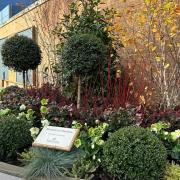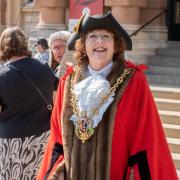Once, while walking through the woods in Kenton Hills, between Leiston Abbey and the sea, I came across a spectacular display of rhododendrons. Their frothy, cerise blooms and glossy green foliage looked eccentric among the soaring plantation pines and shimmering silver birches; a bit like going overdressed to a party.
They were a pleasant surprise though, and a clue to times past. Most likely, they're the plantings of 19th century landowners who once ran the ancient abbey lands there as estates; a frivolous nod to Victorian horticultural fashion. But whichever enthusiast planted them, he or she probably got the idea from another Suffolk person with a passion for exotic plants, Joseph Hooker.
Halesworth-born Sir Joseph Dalton Hooker,botanist, explorer and plant collector, was arguably the most important British botanist of the 19th century. He was Charles Darwin’s closest friend and for 20 years he was director of the Royal Botanic Gardens, Kew.
Born in 1817, he had a botanist's blood coursing through his veins. His father was the famous botanist Sir William Jackson Hooker, Regius Professor of Botany at Glasgow University, who in 1841 became the first official director of the Royal Botanic Gardens, Kew.
Hooker was a seedling, just seven years old, when he started attending his father's lectures at the university. He took an early interest in where plants grew and came from, and was in thrall to explorers like Captain James Cook, avidly following their their voyages and adventures. He went to Glasgow High School, then studied medicine at Glasgow University, graduating with an MD in 1839.
It might seem like his destiny was pre-ordained, but Hooker was not a gentleman of independent means. If he was to pursue his passion for botany he needed to fund it. He also knew that he needed to earn his credentials as a serious scientist; travel and exploration was a very appealing way to do it. His degree qualified him to work in the Naval Medical Service, so he secured a job as assistant surgeon on HMS Erebus for the pioneering 1839-1843 Ross expeditions to the Antarctic, seizing the opportunity for some botanical exploration in the Southern Ocean countries, especially New Zealand.

It was the start of a lifetime devoted to global scientific investigation and discovery that would make him the leading botanist of his time.
Returning from his southern hemisphere adventures, in 1845 Hooker applied for the chair of botany at the University of Edinburgh, which included duties at the Royal Botanic Gardens of Scotland. Hooker missed out on the job, thanks to some local political interference, but was offered a chair at Glasgow University, vacated by John Hutton Balfour who got the Edinburgh job. He turned it down in favour of a position as botanist to the Geological Survey of Great Britain and went to work on palaeobotany, searching for fossil plants in the coal beds of Wales, where he eventually discovered the first coal ball in 1855.
It was interesting work but Hooker had the bug for travel. In 1847 he obtained a government grant to travel in India and the Himalayas and embarked on a three-year trip. Roaming the more remote areas of the Himalaya was not without its hazards; he was the first western plant collector to set foot in those parts and got himself thrown into prison by the Rajah of Sikkim for overstepping the boundaries, literally. But, he still managed to collect about 7,000 plant species, including 25 new species of rhododendrons. Victorian British gardeners were crazy for them.

Hooker wasn't just interested in collecting exotic plants; he wanted to interpret the natural world around him, describing, classifying and understanding what he saw on his travels. He gained a global reputation as an expert in plant distribution; in India, from the highest mountains in the world, he gathered botanical and geological evidence that supported Charles Darwin's theory On the Origin of Species, published in 1859.
Hooker had a close, life-long friendship with Darwin; he dedicated his published Himalayan Journals to him, and the two men confided in one another both personally and professionally. Hooker was Darwin's first confidant for his controversial theory of evolution in a letter dated 1844.
In August 1851, Hooker married Frances Harriet, eldest daughter of John Stevens Henslow, the Cambridge professor of botany who had taught Darwin. Things were going well for him. He and Frances would have four sons and three daughters, and his professional life was in the ascendancy. In 1855, he was appointed assistant director of The Royal Botanic Gardens Kew, and would become director in 1865.

But personal tragedy struck when his daughter Minnie (Maria Elizabeth) died, aged only six, in September 1863. The grief-stricken Hooker found comfort in writing to his friend Darwin, who had lost his daughter a few years earlier.
Then, in 1874, Frances, who had helped her husband by translating French botanical texts that he edited, died aged 49. Hooker ploughed his energy into his work at Kew, developing the gardens' function as a scientific institution, expanding the herbarium collections and overseeing the construction of the first Jodrell Laboratory. Then, in 1876, he married Lady Hyacinth Jardine, widow of Scottish naturalist Sir William Jardine. They had two sons, although family life didn't stop him travelling.
At 60, Hooker's passion for plants was undimmed and he took botanical trips to Morocco and the USA, where he covered 8,000 miles. He published prolifically throughout his life, numerous accounts of the botany he encountered throughout his travels; Flora Antarctica: the botany of the Antarctic voyage (three volumes), the beautifully illustrated Rhododendrons of Sikkim Himalaya, Handbook of the New Zealand flora, and important articles on the relationship of American and Asian floras, following a tour of the Rocky Mountains.

With George Bentham he compiled a world flora, The Genera Plantarum, a project that spanned more than 25 years and was eventually published in 1883. Describing more than 7,500 genera and nearly 100,000 species, it established the Bentham-Hooker model for plant classification and has been called the most outstanding botanical work of the 19th century.
Hooker retired from at Kew in 1885, but his love for botany didn't wither and he worked right up to his death in 1911, aged 94. Such was his standing in the scientific world that it was suggested he be laid to rest at Westminster Abbey, alongside his friend Charles Darwin. The widowed Hyacinth declined the proposal and Hooker was buried, as he wished to be, alongside his father in the churchyard of St Anne's Church, Kew, close to Kew Gardens.





























